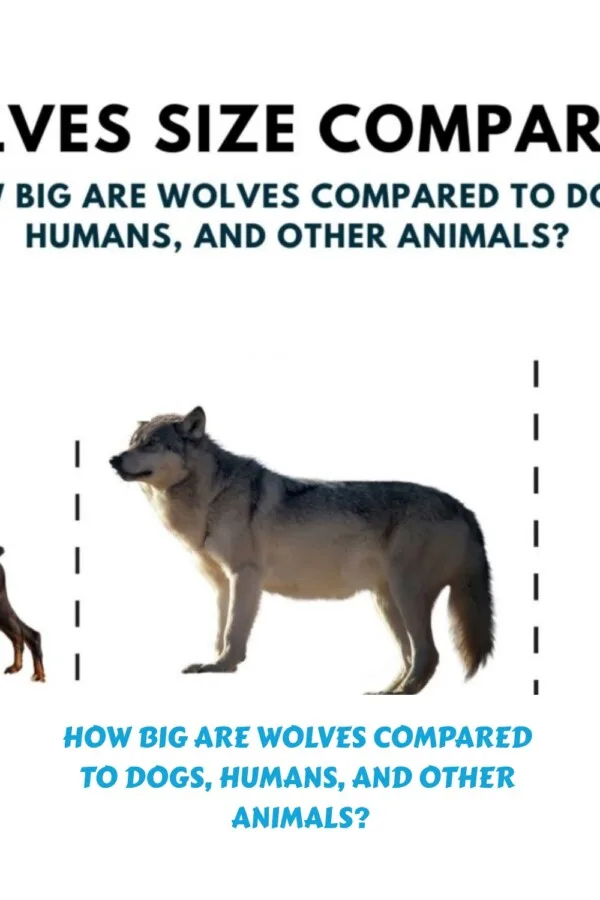Wolves are varied in size, making them an interesting subject for comparison with other animals like dogs and humans. This blog post will discuss how big they are compared to these creatures in particular, as well as others – emphasizing the significance of this impressive predator’s presence within nature!
Key Takeaways
- Understanding the size differences between wolf species and subspecies can help us appreciate their unique adaptations better.
- Wolves are typically larger than most dog breeds, but some exceed in size.
- Adult wolves weigh approximately the same as an average human, though attacks on humans are rare unless provoked.
Understanding Wolf Size: Species and Subspecies
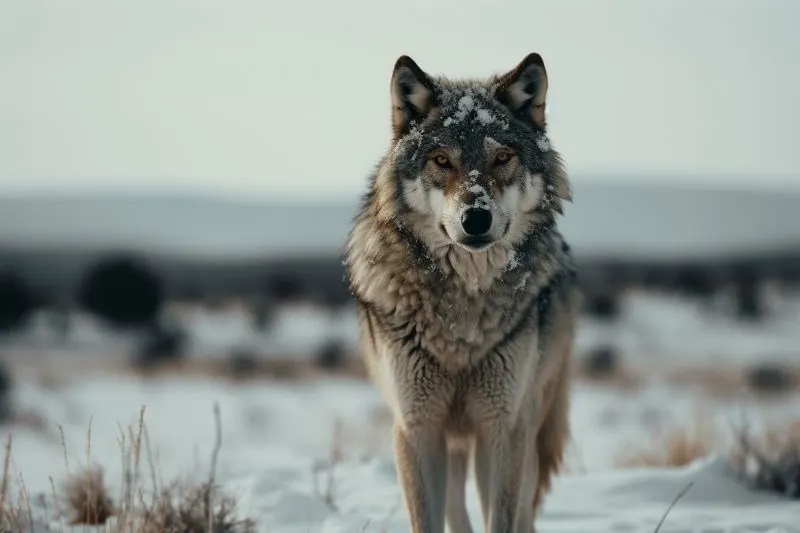
The various species and subspecies of wolves must be considered when assessing their size. Most commonly found is the gray wolf, typically weighing between 80-100 pounds, though they can grow to a staggering 175lbs!
Male adults measure up anywhere from 5 to 6.5 feet in length, with female grey wolves only measuring slightly smaller at 4.5 to 6 feet tall, standing 30 inches high at the shoulder with a slender body profile perfect for traversing across habitats quickly and efficiently.
Two examples of some larger-sized wolf breeds include timberwolves as well as Mackenzie Valley wolves. Conversely, one might find Arabian wolves and wolves noted for having petite frames, making them renowned among Canidae family members as what may be considered the smallest type of Wolf known today!
Other noteworthy varieties like red or eastern come together, adding even more diversity within this majestic creature’s full array sizes. This could account for all necessary adaptations that better enable its survival prowess on numerous levels.
| Species | Average Height (at the shoulder) | Average Weight | Average Length (including tail) |
|---|---|---|---|
| Wolves | 26-32 inches | 70-130 pounds | 4.5-6.5 feet |
| Humans | 5-6 feet (standing upright) | Varies widely | Not applicable |
| Dogs (average) | 6-33 inches | 3-180 pounds | Varies widely |
| Siberian Tigers | 28-39 inches | 200-700 pounds | 6-12 feet |
| Cougars | 24-35 inches | 80-220 pounds | 6.5-8.5 feet |
These variances amongst different types allow us insight into how unique each kind is. It helps us appreciate why such creatures have evolved abundantly since life began many eons ago.
Comparing Wolves to Dogs
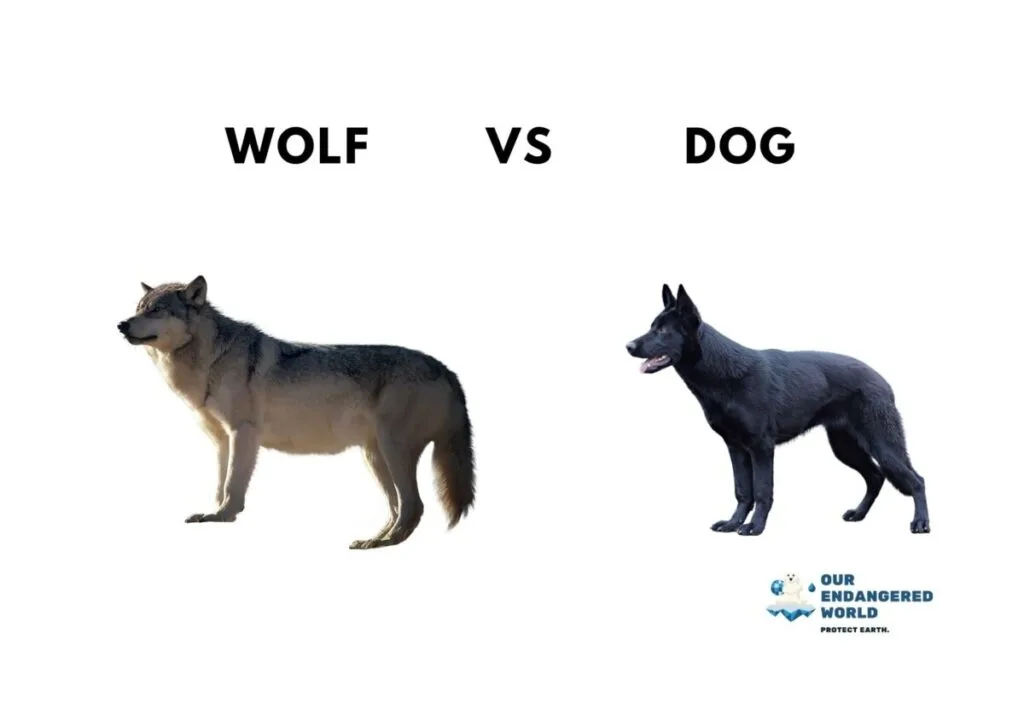
Within the Canidae family, domesticated dogs come in all shapes and sizes. While wolves tend to be larger than most dog breeds, certain canine varieties can reach a size even greater than these wild animals. This demonstrates the wide variety present among members of this family.
| Feature | Wolves | Dogs |
|---|---|---|
| Average Height | 26-32 inches (at the shoulder) | 6-33 inches (at the shoulder) |
| Average Weight | 70-130 pounds | 3-180 pounds |
| Length | 4.5-6.5 feet (nose to tail) | Varies greatly depending on breed |
| Size Variation | Less variation, generally large | Wide range from tiny to giant |
| Largest Recorded | Up to 175 pounds | English Mastiff: Up to 343 pounds |
| Physical Build | Robust, powerful body | Varies from slender to stocky |
| Bite Force | 400 psi (pounds per square inch) | 200-700 psi, breed-dependent |
Wolf vs. Great Dane
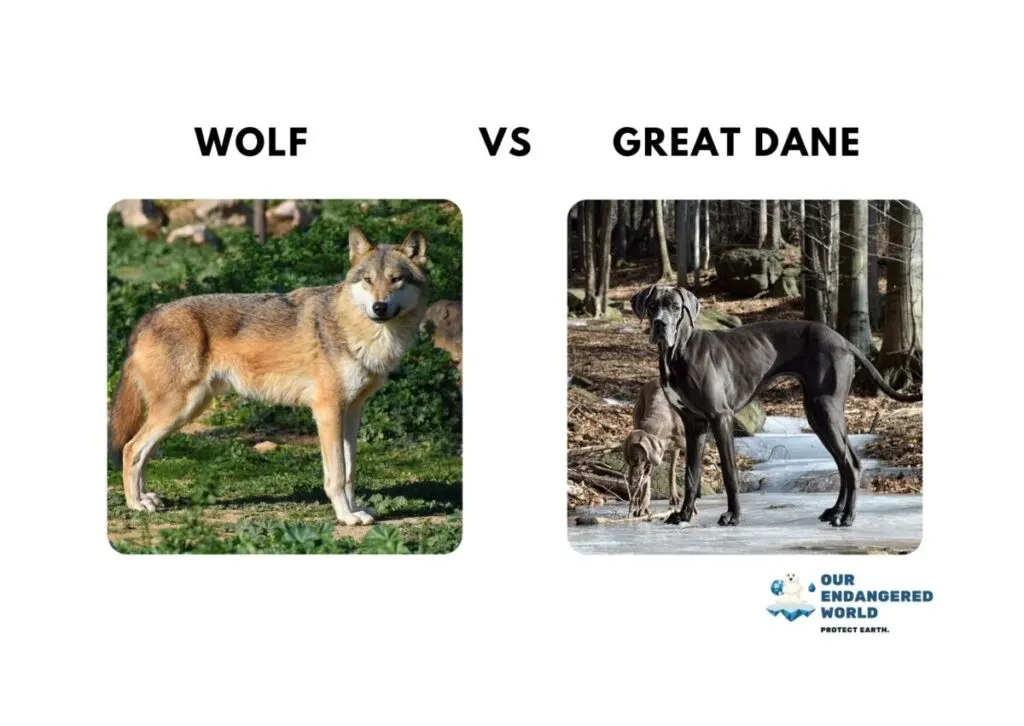
Great Danes, one of the biggest dog breeds in height at up to 34 inches measured from their shoulder, are only slightly taller than an average wolf, which usually stands around 32 inches. A large Gray Wolf can reach a comparable or even bigger size when considering its body length and weight, creating an intimidating visual impression compared to the Great Dane.
Red Wolves, as well as Ethiopian and Maned Wolves, typically have lower heights and weights that don’t measure close to those found on larger dogs such as this dog breed itself.
Humans can be shorter than some species within the broad range of sizes possessed by wolves, demonstrating how they differ greatly amongst each other depending upon type while being more modestly sized next to comparably big canine types like Great Danes.
Wolf vs. Siberian Husky
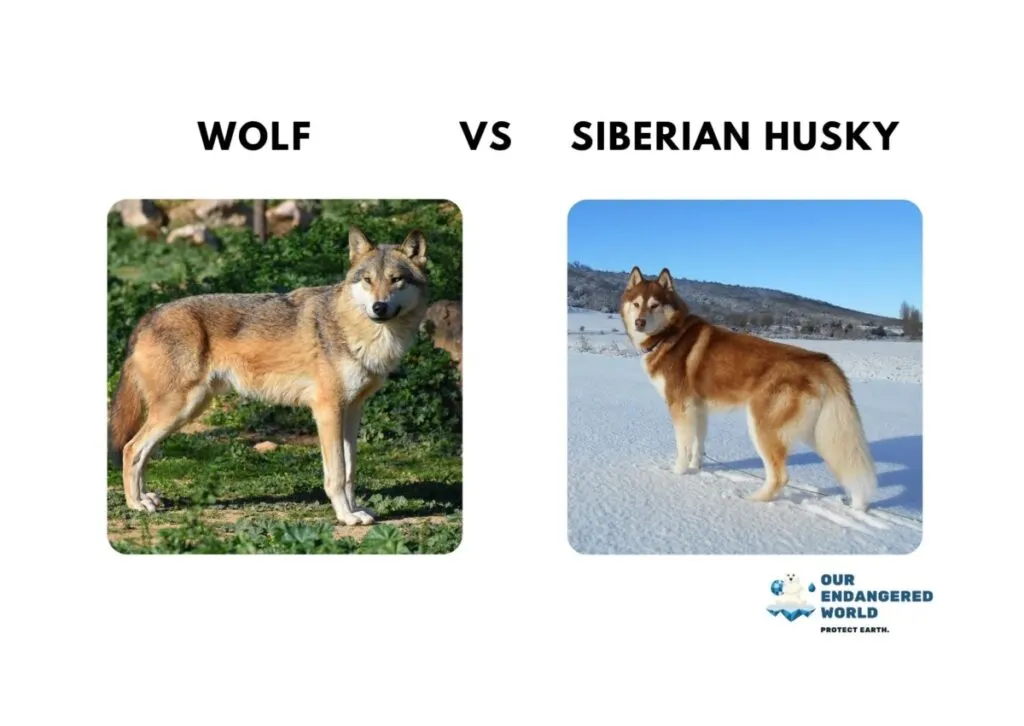
Siberian Huskies and wolves may look similar, but huskies are much smaller. A typical Siberian Husky is noticeably shorter than a wolf, with their height being relatively lower than other Canidae family members. The weight of a husky falls around half as much as that of a wolf size compared to an average-sized wolf’s mass.
This distinct disparity between them helps differentiate them when visually inspecting physical attributes. They appear related yet have adapted differently depending on their environments over time – this demonstrates how varied animals within the same species can be today!
Wolf vs. German Shepherd
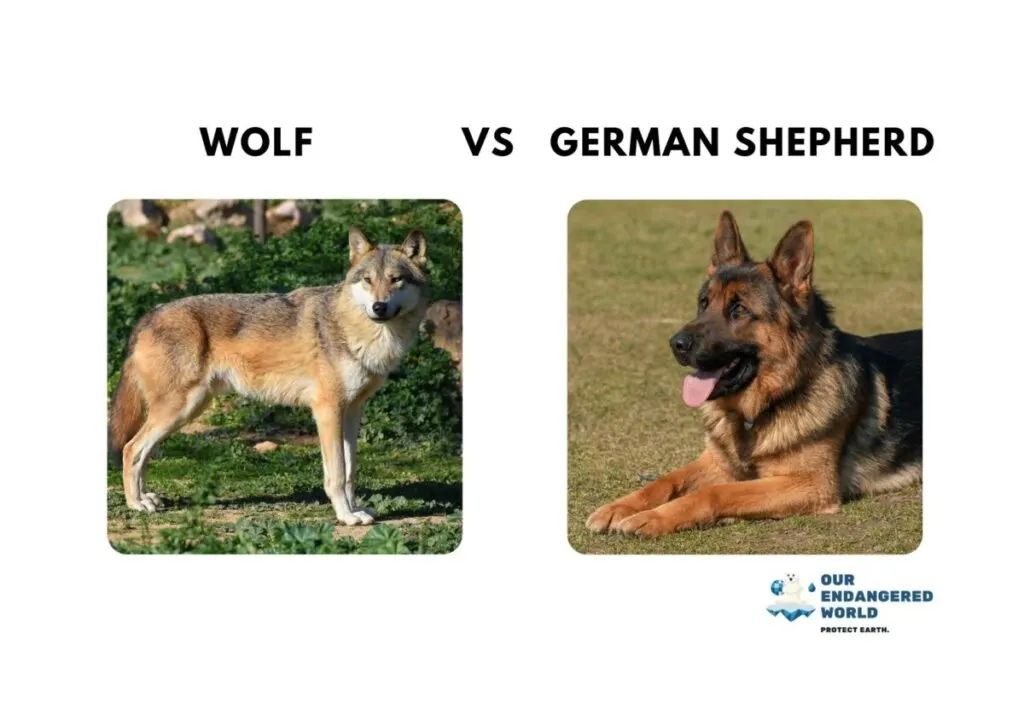
Adult males of the Canidae family, such as wolves, are much larger than German Shepherds and can measure up to 5-6.5 feet in length. Male German Shepherds only reach a height at the shoulder between 24 and 26 inches, while females usually stay around 22 to 24 inches tall at the shoulder comparatively. Recognizing this considerable size difference gives insight into how wolves stand out within their species due to the powerful builds that aid them with surviving life in the wild.
See Related: These Animals Have the Best Hearing in the World
Wolves and Human Size Comparison
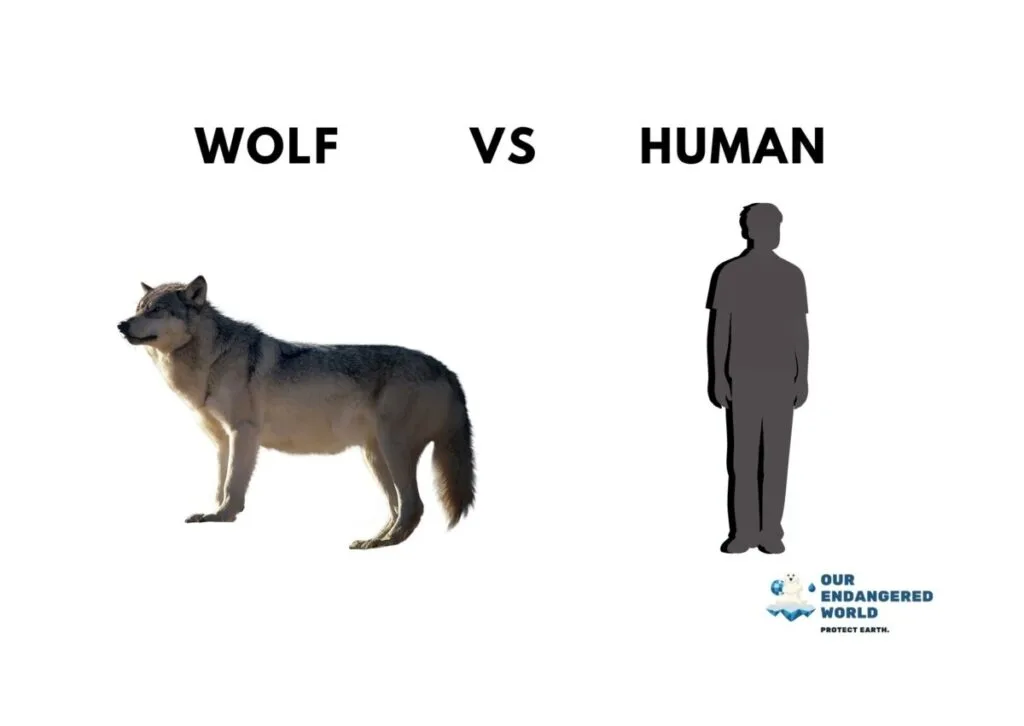
When we compare their size compared to human and humans, wolves are an impressive species. Standing almost as tall as a person when on their hind legs and typically weighing around 135 pounds (62 kg), which is close to the average human weight, these animals still manage to capture our attention despite being smaller than us.
To maintain safety for both sides in areas where people share space with wolves, it’s important to be aware of the creatures’ size and behavior. Although they can appear intimidating due to their considerable dimension, such predators rarely display aggression toward humans unless provoked or threatened by them.
Wolves vs. Other Wild Canids
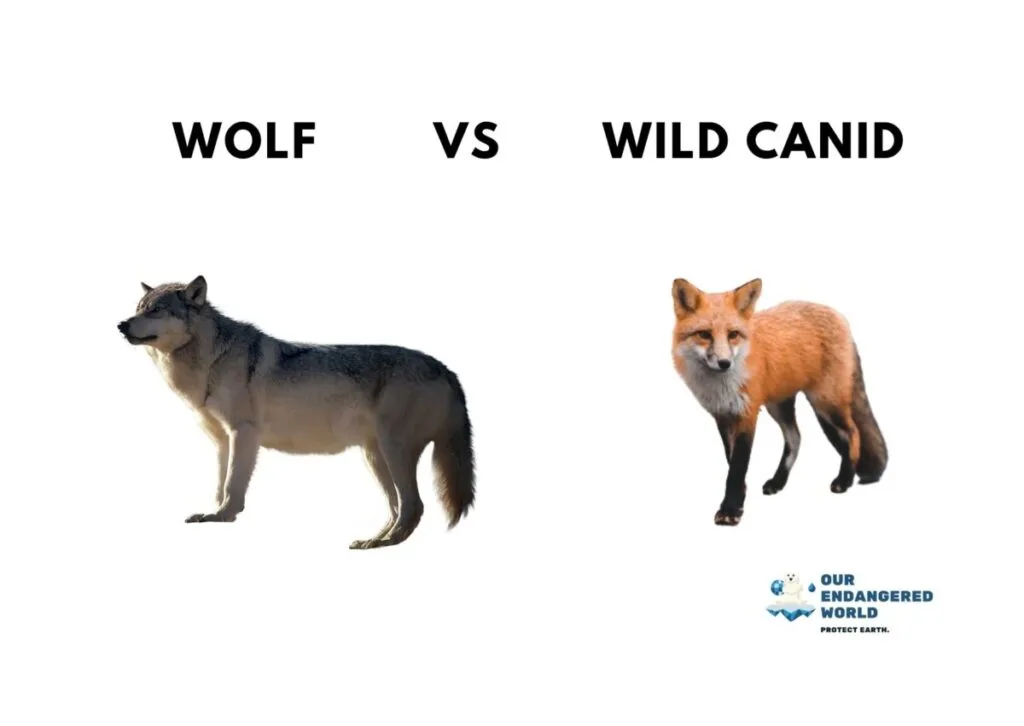
Studying wild relatives of the wolf can reveal insight into their individual characteristics and place within the Canidae family. By comparing wolves to other members of this animal family, a range in size and adaptations becomes evident which aids understanding of why they are unique.
Wolf vs. Coyote
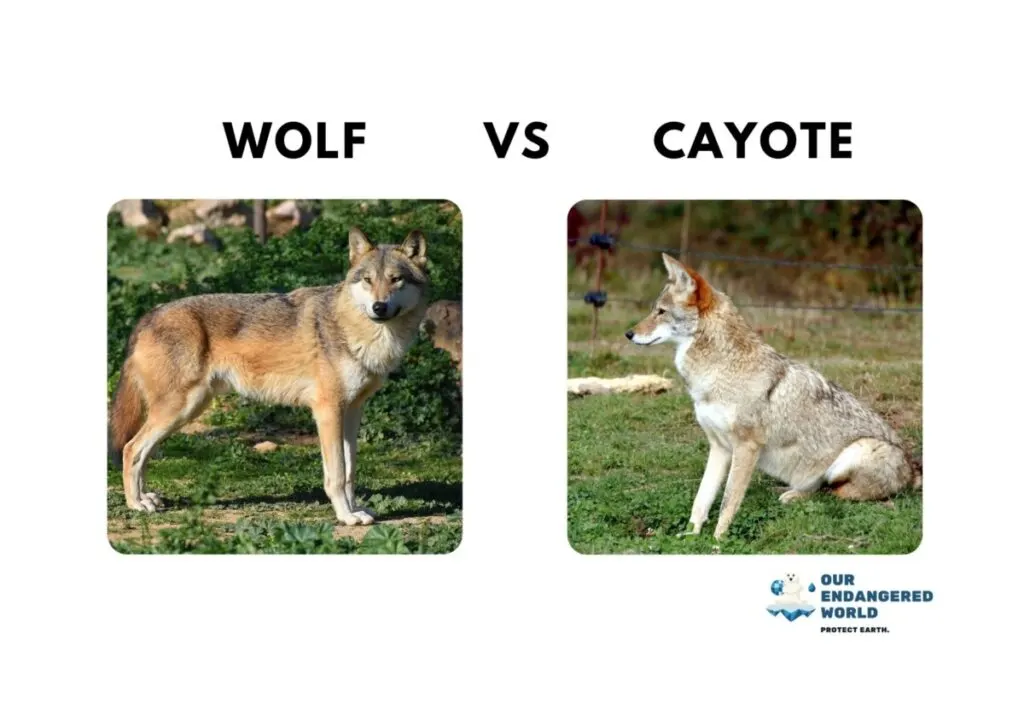
The Canidae family includes two species of wild canids (wolves and coyotes) that are closely related but differ in size. Adult wolves have a shoulder height between 80 to 200 pounds, whereas their smaller cousins, the coyote’s weight ranges from 25 to 40 pounds with body lengths measuring 3.3 to 4.5 feet tall at maximum shoulder level.
Not only is there an obvious difference in stature between them. It also reflects through their paws as wolf paw sizes are approximately twice larger than those of a coyote’s presenting us more evidence for diversity within this genus aside from just physical features, adapting each one better into its environment.
Wolf vs. Fox
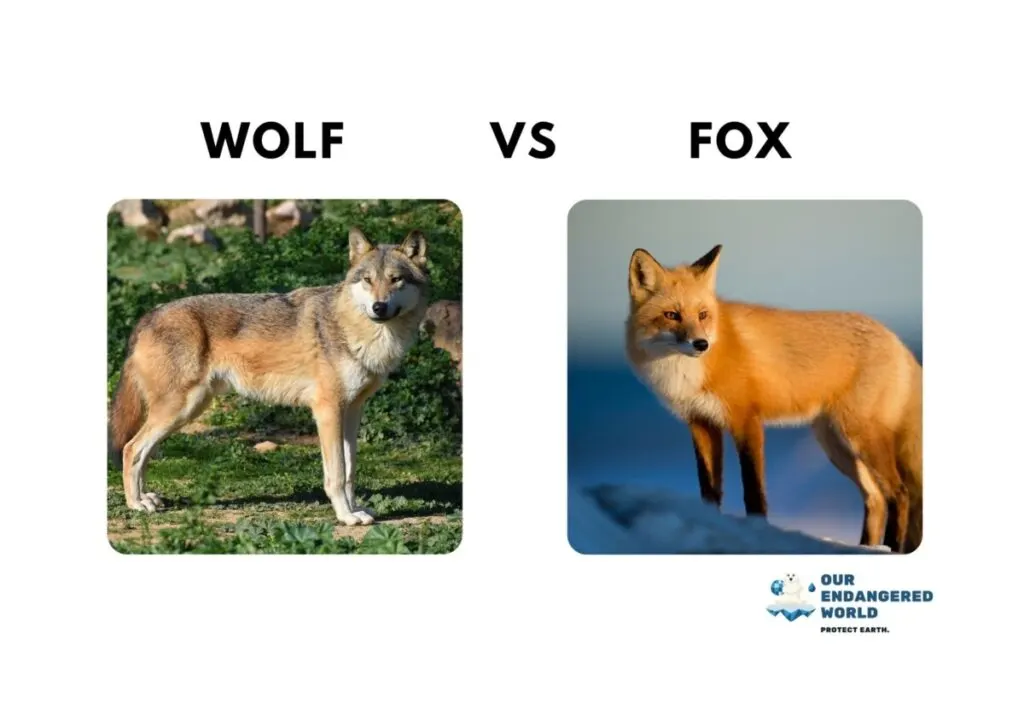
The Canidae family is remarkably varied, with wolves and foxes being a prime example of this. Wolves tend to be much heavier than their counterparts. They can reach an average weight of 80-100 pounds, while red foxes typically weigh 10-15 pounds (5 – 7 kg).
In contrast to the solid build that comes along with a larger size for most animals in this family, foxes are normally taller than wolves and typically weigh less wide. This highlights how different both species are when placed side by side primarily because each has adapted differently throughout time based on its habitat requirements.
See Related: Red Wolf: Why Is It Endangered?
Wolf vs. African Wild Dog
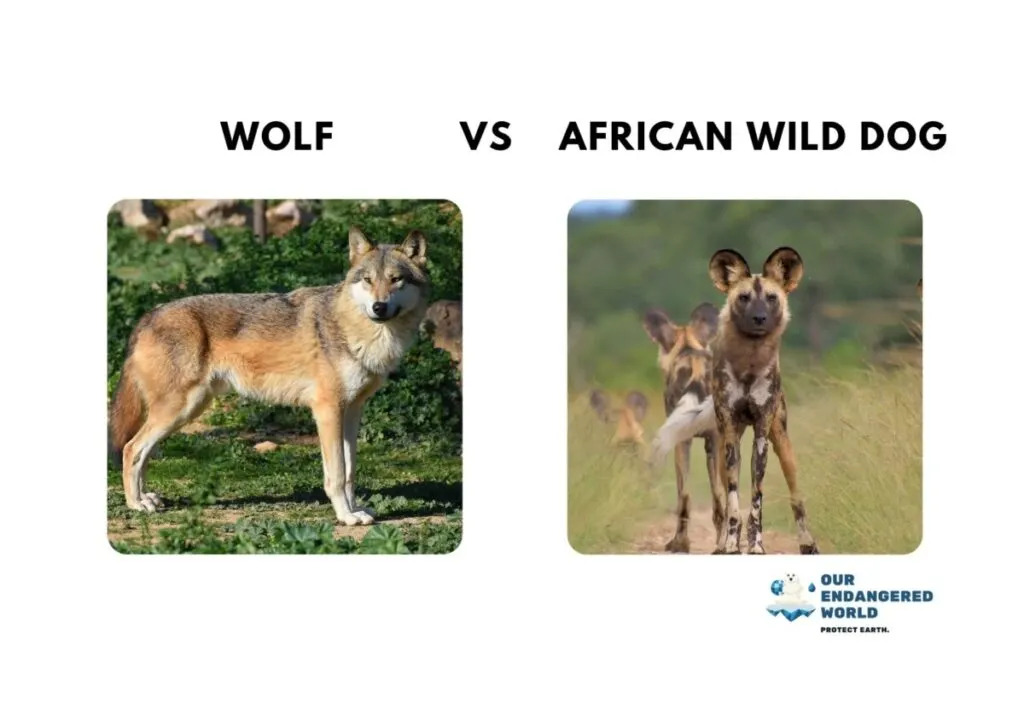
Compared to wolves, African Wild Dogs are somewhat smaller. They tend to stand 24-30 inches from the shoulder and usually weigh 40 to 80 pounds. Like their relatives in the Canidae family, these animals possess a slender yet active figure that gives them an advantage when hunting prey.
The two species demonstrate how versatile this animal group is by having special traits that enable them to survive successfully in their environment. It emphasizes the rich variety within members of the Canid family and how even slight adaptations make immense differences for survival purposes.
Comparing Wolves to Large Predators
The size of wolves relative to other powerful predators across the globe can be enlightening regarding their standing in the animal kingdom and dealing with ecological circumstances. The gray or grey wolf, also called wild canine, is the largest among its kin. How does this particular species of timber wolf compare against others at large?
To better understand how big wolves are compared to global predators, we must consider each creature’s comparative size and capabilities – which often help them thrive within specific environments.
Wolf vs. Lion
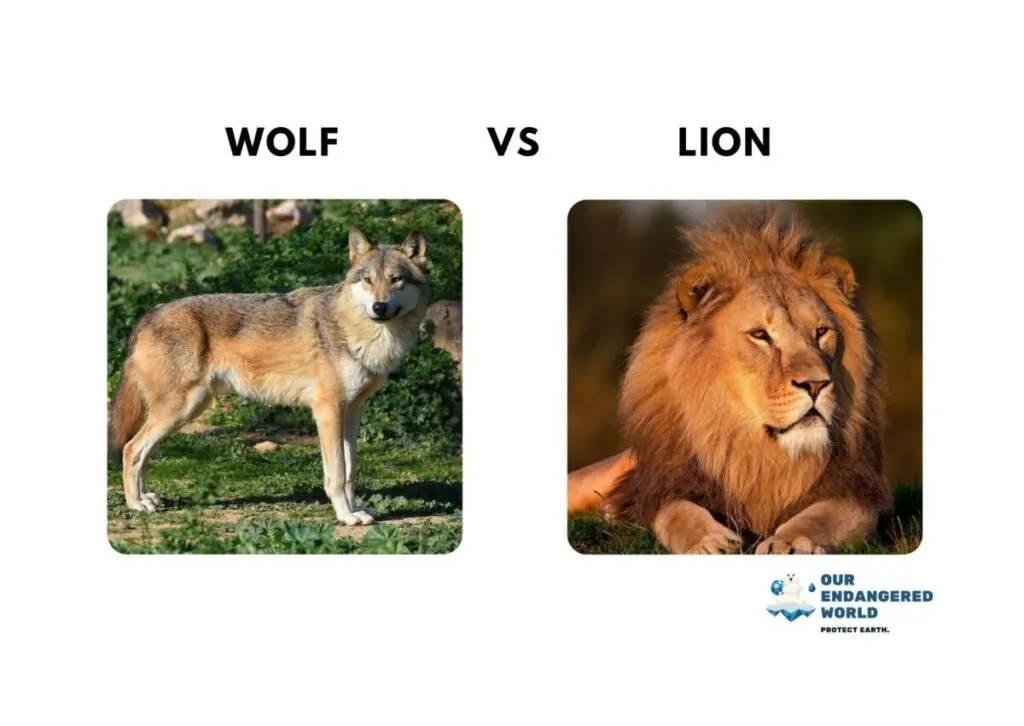
When it comes to wolf size comparison with lions, one can immediately notice the considerable disparity between them.
Male lions are significantly larger than male wolves and usually reach lengths ranging from 1.7 to 2.5 meters (or 5.6-8.2 ft) measured from their nose tip up until tail’s end, while females tend to measure somewhere around 1-1 7/4 meters (4. 6, 5. 7 ft). Adult wolves typically do not exceed the limit of two meters in total length or 4,5 – 6,5 feet when stretched out completely, starting at their snouts down until tail’s endpoint.
Even though they may be smaller compared to lion specimens, these wild predators make good use of ingenuity along with powerful jaws plus group hunting tactics to hunt for sustenance successfully.
Wolf vs. Tiger
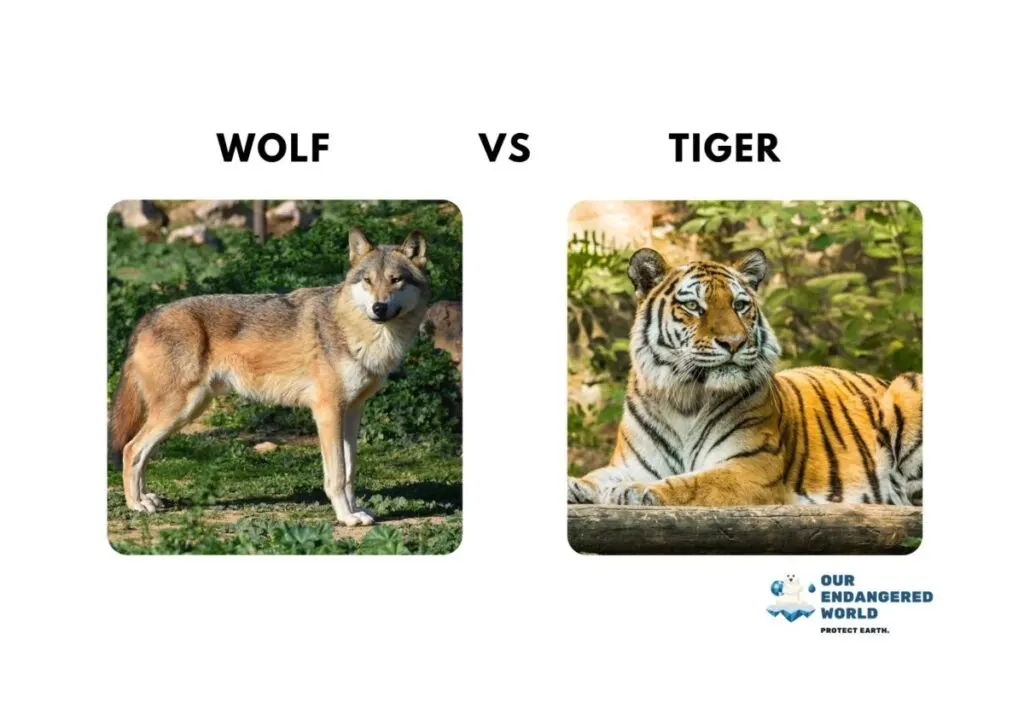
Tigers, the most prominent big cats, are bigger than wolves. On average, these felines can reach lengths up to 10-12 feet and have a maximum weight of 310 pounds.
Their canine counterparts are at the top end, the largest wolf species regarding measurements. They normally measure around 6 ft long with an approximate 175-pound mass.
This striking difference between wolves and tigers demonstrates that apex predators adapt extremely well according to varied surroundings. Despite being more diminutive, wolves remain formidable hunters due both to their herd techniques as well as physical properties, allowing them to thrive even under challenging conditions.
See Related: Amur Tiger: Why is it Endangered?
Wolf vs. Hyena
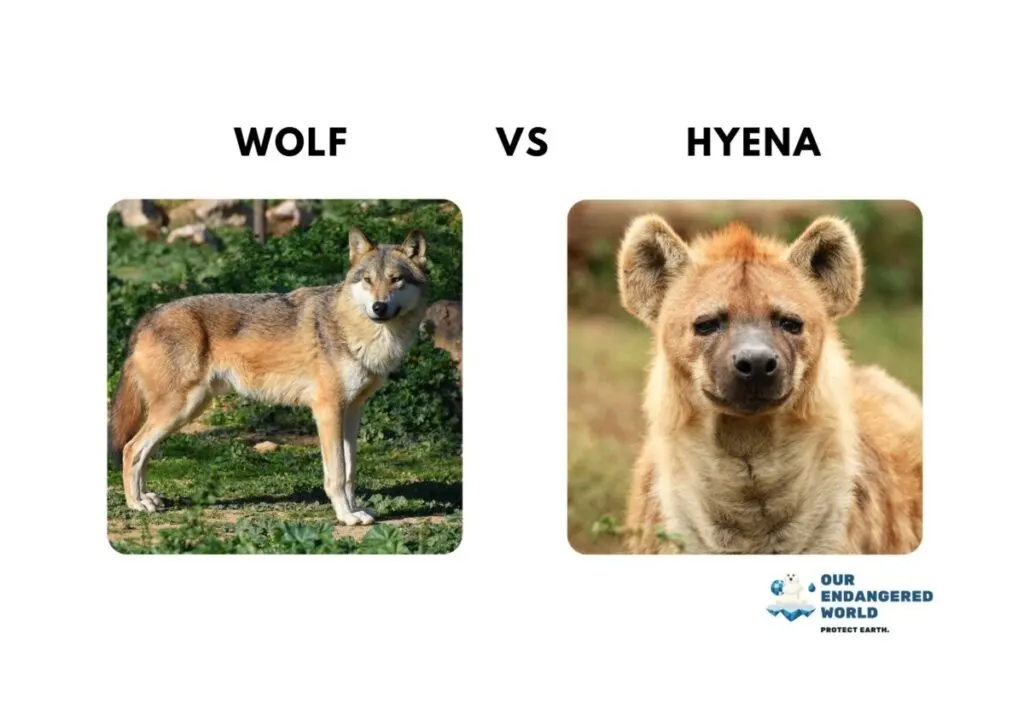
It is clear that wolves are taller and longer than most hyenas. They can possess a similar weight as the spotted variety of these animals. This size disparity between species with related social systems presents an understanding of their individualized characteristics meant for existing in diverse environments.
Both types of creatures have intelligence, sharp teeth, and joint hunting schemes which assist them in being successful hunters. Perceiving how distinct their dimensions may provide insight into why each had to evolve particular behaviors or attributes for survival success.
The Dire Wolf: A Prehistoric Comparison

The dire wolf of prehistory was much like the common gray wolf in size. While 25% more massive than their modern-day relatives, they had a similar height and length overall. We know this ancient predator may have weighed up to 175 pounds – within range for present-day species’ maximums, too.
Considering their large skull and robust jaws relative to body size. It is not difficult to understand how such animals could be formidable hunters back then, just as contemporary varieties of red wolves are today. Comparing these two creatures through history allows us to value them together and their traits over time.
Summary
In summary, wolves come in various sizes based on their species and subspecies. By using the smallest wolf species and comparing them with dogs, humans, and other animals, we can learn more about how they have evolved to suit their environment as well as where the wolf fits within the Canidae family and its place among all creatures.
Wolves show impressive predatory characteristics that allow them to compete against larger predators, which has been seen since prehistory when dire wolves roamed wild. This is still relevant today, with various existing species showing it’s continuing success over time.
Frequently Asked Questions
How big is a full-size wolf?
The typical full-sized wolf is around three to five feet long and can weigh between sixty and one hundred forty-five pounds. Its height at the shoulders ranges from 26+ inches at the shoulder to up to 32 inches, while its tails typically measure 1 foot (maximum of two).
What are the different sizes of wolves?
The size of wolves can range from the smallest, such as the Ethiopian Wolf (25 inches tall and up to 3.5 feet long), to the largest, the Gray Wolf (up to 32 inches tall and 6.5 feet long), with the mean body mass of adult male wolves being 40 kg (88 lb). The smallest recorded average lion weighs 12 kg (26 lb), while the largest is 79,4 kg (175 lb).
How big are wolves compared to adults?
Wolves are typically of a smaller stature than humans, averaging around five to six feet tall, and the average wolf weighs approximately 62 kilograms.
Are there any dog breeds larger than wolves?
Certain dog breeds, such as the Great Dane, can in fact, grow to be larger than wolves, which may come as a surprise.
How does the size of the prehistoric dire wolf compare to modern-day wolves?
The dire wolf of prehistory was slightly bigger than the regular wolf we see today, estimated to weigh 25% more.
Related Resources
- Most Beautiful & Majestic Animals in the World
- These Are the Strongest Animals in the World
- Most Comfortable Animals in the World

